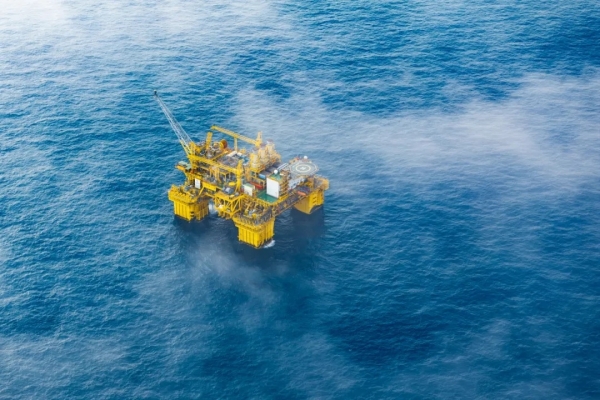In the past five years, China National Offshore Oil Corporation (CNOOC) has achieved 104 percent and 143 percent respectively of its targets for newly proven geological reserves of oil and gas.
Last year, CNOOC’s reserve replacement rate reached 180 percent, with reserve lifespans maintained at over 10 years for seven consecutive years.
The “Deep Sea No. 1” production platform, since its inception three years ago, has produced 8 billion cubic meters of natural gas and over 800,000 cubic meters of condensate oil, marking a significant achievement in deepwater development.

An aerial view of the “Deep Sea No. 1” platform [Photo/sasac.gov.cn]
CNOOC’s commitment to deepwater exploration is underscored by its determination to tackle complex geological challenges. With significant discoveries in deepwater fields like Lingshui 36-1 and Baodao 21-1, the company is strategically positioned to lead the industry.
Data show that in the past decade, 100 large oil and gas fields have been discovered globally, with deepwater fields accounting for 57 percent of the number and 68 percent of their reserves. In China, deep and ultra-deep oil and gas resources total 67.1 billion tons of oil equivalent, constituting 34 percent of the nation’s total oil and gas resources.
In 2023, China’s marine crude oil production surpassed 62 million tons, with less than 10 percent coming from deepwater and deep layers. Compared to shallow and mid-shallow traditional exploration fields, the exploration level in deepwater and deep layers is still low, making them key potential areas for future oil and gas reserves and production growth.
However, venturing into deeper waters also increases challenges. The Kaiping South Oilfield is one of the examples that narrate the story of decades of effort by CNOOC personnel to conquer deepwater and deep layers.
In the 1980s and 1990s, several international oil companies drilled multiple exploratory wells in the Kaiping depression, but failed to make the expected large discoveries. The companies even concluded that there was no potential in the depression for hydrocarbon production or exploration value. At the beginning of this century, self-operated exploration still faced similar challenges. The Kaiping depression was labeled as a “cold zone” for exploration.
Since the commencement of self-operated exploration, CNOOC researchers discovered that the geological structure of the deepwater area in the northern South China Sea differs from that of typical deepwater oil and gas basins worldwide.
In 2019, a task force re-collected 3D seismic data. Over two years, they have mapped over 3,000 square kilometers, identified more than 4,000 fault lines, and established seven critical interfaces, effectively characterizing previously unencountered complex formations.
Around the same time, numerous deepwater and deep layer areas in the northern South China Sea completed their 3D seismic surveys. With fresh seismic data available, foundational research initiatives were promptly launched.

Kaiping 11-4, the first well in the southern part of Kaiping, achieves high production rates during testing. [Photo/sasac.gov.cn]
Then, CNOOC personnel proposed relocating the exploration focus from the northern region to the southern slope area. The first well in the southern part of Kaiping, Kaiping 11-4, began drilling in June 2021. At 3,300 meters, it yielded continuous oil and gas shows. However, excitement quickly turned to disappointment when three subsequent appraisal wells all encountered failure.
The scale of hydrocarbon source rocks dictates exploration depth and breadth, and only by clarifying the potential of source rocks can breakthroughs occur in exploration. The CNOOC exploration team then researched the hydrocarbon source rocks that had previously been disregarded.
Through persistent exploration, the long-anticipated breakthrough arrived: the discovery of the Kaiping18-1 gas field. The transformation from exploration of “cold zones” to active oil discoveries had been an extraordinary journey.
On August 7, 2024, CNOOC officially announced the discovery of the ultra-deepwater, ultra-shallow Lingshui 36-1 gas field, with proven geological reserves exceeding 100 billion cubic meters. This groundbreaking find not only fills a global gap in ultra-deepwater exploration but also significantly enhances the development of China’s trillion-cubic-meter gas area in the South China Sea.
CNOOC is enhancing its reputation while providing a valuable model for expanding deepwater oil and gas exploration in China, thereby contributing to national energy security and supporting the construction of maritime power.
(Executive editor: Zhu Zeya)